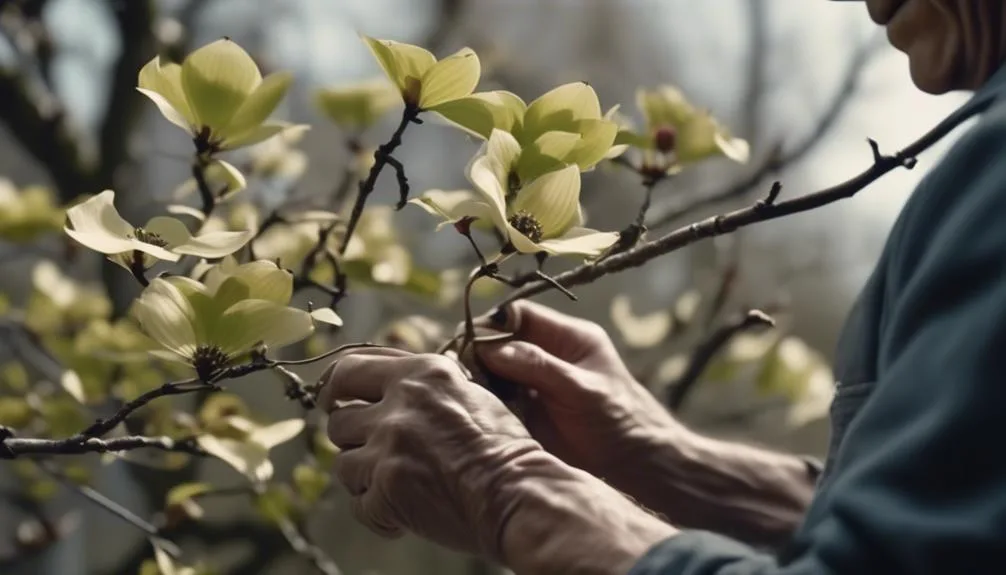Have you ever admired a dogwood tree, seeing it as a graceful dancer in the wind? Just like dancers, dogwood trees can be shaped and trained to enhance their natural beauty.
There are different methods for pruning, training young trees, and shaping mature ones to achieve the ideal look.
Stick around to learn the secrets of shaping and training dogwood trees, and discover the tips for maintaining their beautiful form.
Pruning Dogwood Trees
If you want to keep your dogwood trees healthy and beautiful, regular pruning is essential. Proper dogwood tree care involves using the right pruning techniques to maintain their shape and promote healthy growth.
Start by removing any dead, damaged, or diseased branches to prevent the spread of infection. When pruning, make clean cuts at a 45-degree angle just above a bud or lateral branch to encourage new growth.
Additionally, thin out crowded areas to improve air circulation and sunlight penetration, which can help prevent diseases. Pruning dogwood trees in late winter while they're dormant is ideal, as it allows the wounds to heal before the growing season begins.
Following these pruning techniques as part of your overall dogwood tree care routine will ensure your trees remain vibrant and beautiful year after year.
Training Young Dogwood Trees
To train young dogwood trees for optimal growth and form, carefully guide their branches by using gentle ties or stakes to encourage a balanced and sturdy structure. As the tree grows, it's important to maintain a central leader, which is the main upward-growing stem, and prune any competing leaders to promote a strong tree structure. Keep an eye on the growth patterns of the branches, ensuring they are evenly distributed to prevent overcrowding and encourage proper air circulation. Here's a helpful table to illustrate some key points for training young dogwood trees:
| Training Tips | Description |
|---|---|
| Use Gentle Ties | Secure branches without causing damage |
| Maintain Central Leader | Encourages upward growth and strong structure |
| Prune Competing Leaders | Promotes a single, sturdy trunk |
| Monitor Branch Growth | Ensure even distribution for balanced tree structure |
| Encourage Air Circulation | Prevents overcrowding and disease |
Shaping Mature Dogwood Trees
As your young dogwood trees mature, shaping them to maintain a balanced and sturdy structure becomes essential for promoting their continued growth and health. Employ tree shaping techniques such as artistic pruning to enhance the aesthetic appeal and structural integrity of mature dogwood trees.
Consider topiary design and tree sculpture to create unique and visually striking shapes. Pruning mature dogwood trees can help control their size and shape, prevent overcrowding, and improve air circulation within the canopy.
When shaping mature dogwood trees, focus on removing dead or diseased branches, crossing limbs, and any growth that disrupts the tree's form. By employing these techniques, you can ensure that your mature dogwood trees remain healthy, visually pleasing, and well-suited to their environment.
Maintaining Dogwood Tree Form
Maintain the form of your dogwood tree by regularly inspecting for any signs of irregular growth or damage that may affect its health and appearance. To ensure your dogwood tree maintains its desired structure and growth patterns, follow these tips:
- Pruning: Regularly prune your dogwood tree to remove dead or diseased branches and maintain its shape. Use clean, sharp tools to make precise cuts without causing unnecessary damage.
- Support and Training: Provide support for young dogwood trees to encourage proper growth and prevent structural issues. Use stakes or ties to train the tree's growth in the desired direction and prevent it from leaning or developing weak branches.
Tips for Shaping and Training Dogwood Trees
When shaping and training dogwood trees, it's essential to start with a strong and healthy young tree to ensure successful growth and form. Proper tree structure is crucial, so start by selecting a main leader branch and several well-spaced lateral branches to serve as the tree's framework.
As the tree grows, prune away any competing or crossing branches to maintain an open and balanced form. Branch manipulation can be achieved by using stakes or ties to gently guide the branches into the desired shape. Be mindful of the tree's natural growth habits and avoid forcing it into unnatural forms.
Regularly inspect the tree for any signs of stress or damage, and adjust your shaping and training techniques accordingly. With patience and proper care, your dogwood tree will develop into a beautifully shaped and trained specimen.
Conclusion
To maintain the form and enhance the beauty of dogwood trees, shaping and training them is essential. By pruning and training young trees while shaping mature ones, you can achieve the desired look.
Regular maintenance is key for their health and longevity, ensuring years of stunning beauty. How will you shape and train your dogwood trees to create a lasting natural masterpiece?

My interest in trees started when I first saw the giant sequoias in Yosemite.
I was a teenager then, and I remember thinking, “I need to learn more about this.”
That moment stuck with me.
A few years later, I went on to study forestry at Michigan Tech.
Since graduating, I’ve worked in a mix of hands-on tree care and community education.
I’ve spent over ten years helping people understand how to plant, maintain, and protect the trees in their neighborhoods.
I don’t see trees as just part of the landscape.
They are living things that make a real difference in our daily lives.
